16.1 Traveling Waves
Learning objectives.
By the end of this section, you will be able to:
- Describe the basic characteristics of wave motion
- Define the terms wavelength, amplitude, period, frequency, and wave speed
- Explain the difference between longitudinal and transverse waves, and give examples of each type
- List the different types of waves
We saw in Oscillations that oscillatory motion is an important type of behavior that can be used to model a wide range of physical phenomena. Oscillatory motion is also important because oscillations can generate waves, which are of fundamental importance in physics. Many of the terms and equations we studied in the chapter on oscillations apply equally well to wave motion ( Figure 16.2 ).

Types of Waves
A wave is a disturbance that propagates, or moves from the place it was created. There are three basic types of waves: mechanical waves, electromagnetic waves, and matter waves.
Basic mechanical wave s are governed by Newton’s laws and require a medium. A medium is the substance mechanical waves propagate through, and the medium produces an elastic restoring force when it is deformed. Mechanical waves transfer energy and momentum, without transferring mass. Some examples of mechanical waves are water waves, sound waves, and seismic waves. The medium for water waves is water; for sound waves, the medium is usually air. (Sound waves can travel in other media as well; we will look at that in more detail in Sound .) For surface water waves, the disturbance occurs on the surface of the water, perhaps created by a rock thrown into a pond or by a swimmer splashing the surface repeatedly. For sound waves, the disturbance is a change in air pressure, perhaps created by the oscillating cone inside a speaker or a vibrating tuning fork. In both cases, the disturbance is the oscillation of the molecules of the fluid. In mechanical waves, energy and momentum transfer with the motion of the wave, whereas the mass oscillates around an equilibrium point. (We discuss this in Energy and Power of a Wave .) Earthquakes generate seismic waves from several types of disturbances, including the disturbance of Earth’s surface and pressure disturbances under the surface. Seismic waves travel through the solids and liquids that form Earth. In this chapter, we focus on mechanical waves.
Electromagnetic waves are associated with oscillations in electric and magnetic fields and do not require a medium. Examples include gamma rays, X-rays, ultraviolet waves, visible light, infrared waves, microwaves, and radio waves. Electromagnetic waves can travel through a vacuum at the speed of light, v = c = 2.99792458 × 10 8 m/s . v = c = 2.99792458 × 10 8 m/s . For example, light from distant stars travels through the vacuum of space and reaches Earth. Electromagnetic waves have some characteristics that are similar to mechanical waves; they are covered in more detail in Electromagnetic Waves .
Matter waves are a central part of the branch of physics known as quantum mechanics. These waves are associated with protons, electrons, neutrons, and other fundamental particles found in nature. The theory that all types of matter have wave-like properties was first proposed by Louis de Broglie in 1924. Matter waves are discussed in Photons and Matter Waves .
Mechanical Waves
Mechanical waves exhibit characteristics common to all waves, such as amplitude, wavelength, period, frequency, and energy. All wave characteristics can be described by a small set of underlying principles.
The simplest mechanical waves repeat themselves for several cycles and are associated with simple harmonic motion. These simple harmonic waves can be modeled using some combination of sine and cosine functions. For example, consider the simplified surface water wave that moves across the surface of water as illustrated in Figure 16.3 . Unlike complex ocean waves, in surface water waves, the medium, in this case water, moves vertically, oscillating up and down, whereas the disturbance of the wave moves horizontally through the medium. In Figure 16.3 , the waves causes a seagull to move up and down in simple harmonic motion as the wave crests and troughs (peaks and valleys) pass under the bird. The crest is the highest point of the wave, and the trough is the lowest part of the wave. The time for one complete oscillation of the up-and-down motion is the wave’s period T . The wave’s frequency is the number of waves that pass through a point per unit time and is equal to f = 1 / T . f = 1 / T . The period can be expressed using any convenient unit of time but is usually measured in seconds; frequency is usually measured in hertz (Hz), where 1 Hz = 1 s −1 . 1 Hz = 1 s −1 .
The length of the wave is called the wavelength and is represented by the Greek letter lambda ( λ ) ( λ ) , which is measured in any convenient unit of length, such as a centimeter or meter. The wavelength can be measured between any two similar points along the medium that have the same height and the same slope. In Figure 16.3 , the wavelength is shown measured between two crests. As stated above, the period of the wave is equal to the time for one oscillation, but it is also equal to the time for one wavelength to pass through a point along the wave’s path.
The amplitude of the wave ( A ) is a measure of the maximum displacement of the medium from its equilibrium position. In the figure, the equilibrium position is indicated by the dotted line, which is the height of the water if there were no waves moving through it. In this case, the wave is symmetrical, the crest of the wave is a distance + A + A above the equilibrium position, and the trough is a distance − A − A below the equilibrium position. The units for the amplitude can be centimeters or meters, or any convenient unit of distance.
The water wave in the figure moves through the medium with a propagation velocity v → . v → . The magnitude of the wave velocity is the distance the wave travels in a given time, which is one wavelength in the time of one period, and the wave speed is the magnitude of wave velocity. In equation form, this is
This fundamental relationship holds for all types of waves. For water waves, v is the speed of a surface wave; for sound, v is the speed of sound; and for visible light, v is the speed of light.
Transverse and Longitudinal Waves
We have seen that a simple mechanical wave consists of a periodic disturbance that propagates from one place to another through a medium. In Figure 16.4 (a), the wave propagates in the horizontal direction, whereas the medium is disturbed in the vertical direction. Such a wave is called a transverse wave . In a transverse wave, the wave may propagate in any direction, but the disturbance of the medium is perpendicular to the direction of propagation. In contrast, in a longitudinal wave or compressional wave, the disturbance is parallel to the direction of propagation. Figure 16.4 (b) shows an example of a longitudinal wave. The size of the disturbance is its amplitude A and is completely independent of the speed of propagation v .
A simple graphical representation of a section of the spring shown in Figure 16.4 (b) is shown in Figure 16.5 . Figure 16.5 (a) shows the equilibrium position of the spring before any waves move down it. A point on the spring is marked with a blue dot. Figure 16.5 (b) through (g) show snapshots of the spring taken one-quarter of a period apart, sometime after the end of` the spring is oscillated back and forth in the x -direction at a constant frequency. The disturbance of the wave is seen as the compressions and the expansions of the spring. Note that the blue dot oscillates around its equilibrium position a distance A , as the longitudinal wave moves in the positive x -direction with a constant speed. The distance A is the amplitude of the wave. The y -position of the dot does not change as the wave moves through the spring. The wavelength of the wave is measured in part (d). The wavelength depends on the speed of the wave and the frequency of the driving force.
Waves may be transverse, longitudinal, or a combination of the two. Examples of transverse waves are the waves on stringed instruments or surface waves on water, such as ripples moving on a pond. Sound waves in air and water are longitudinal. With sound waves, the disturbances are periodic variations in pressure that are transmitted in fluids. Fluids do not have appreciable shear strength, and for this reason, the sound waves in them are longitudinal waves. Sound in solids can have both longitudinal and transverse components, such as those in a seismic wave. Earthquakes generate seismic waves under Earth’s surface with both longitudinal and transverse components (called compressional or P-waves and shear or S-waves, respectively). The components of seismic waves have important individual characteristics—they propagate at different speeds, for example. Earthquakes also have surface waves that are similar to surface waves on water. Ocean waves also have both transverse and longitudinal components.
Example 16.1
Wave on a string.
- The speed of the wave can be derived by dividing the distance traveled by the time.
- The period of the wave is the inverse of the frequency of the driving force.
- The wavelength can be found from the speed and the period v = λ / T . v = λ / T .
- The first wave traveled 30.00 m in 6.00 s: v = 30.00 m 6.00 s = 5.00 m s . v = 30.00 m 6.00 s = 5.00 m s .
- The period is equal to the inverse of the frequency: T = 1 f = 1 2.00 s −1 = 0.50 s . T = 1 f = 1 2.00 s −1 = 0.50 s .
- The wavelength is equal to the velocity times the period: λ = v T = 5.00 m s ( 0.50 s ) = 2.50 m . λ = v T = 5.00 m s ( 0.50 s ) = 2.50 m .
Significance
Check your understanding 16.1.
When a guitar string is plucked, the guitar string oscillates as a result of waves moving through the string. The vibrations of the string cause the air molecules to oscillate, forming sound waves. The frequency of the sound waves is equal to the frequency of the vibrating string. Is the wavelength of the sound wave always equal to the wavelength of the waves on the string?
Example 16.2
Characteristics of a wave.
- The amplitude and wavelength can be determined from the graph.
- Since the velocity is constant, the velocity of the wave can be found by dividing the distance traveled by the wave by the time it took the wave to travel the distance.
- The period can be found from v = λ T v = λ T and the frequency from f = 1 T . f = 1 T .
- The distance the wave traveled from time t = 0.00 s t = 0.00 s to time t = 3.00 s t = 3.00 s can be seen in the graph. Consider the red arrow, which shows the distance the crest has moved in 3 s. The distance is 8.00 cm − 2.00 cm = 6.00 cm . 8.00 cm − 2.00 cm = 6.00 cm . The velocity is v = Δ x Δ t = 8.00 cm − 2.00 cm 3.00 s − 0.00 s = 2.00 cm/s . v = Δ x Δ t = 8.00 cm − 2.00 cm 3.00 s − 0.00 s = 2.00 cm/s .
- The period is T = λ v = 8.00 cm 2.00 cm/s = 4.00 s T = λ v = 8.00 cm 2.00 cm/s = 4.00 s and the frequency is f = 1 T = 1 4.00 s = 0.25 Hz . f = 1 T = 1 4.00 s = 0.25 Hz .
Check Your Understanding 16.2
The propagation velocity of a transverse or longitudinal mechanical wave may be constant as the wave disturbance moves through the medium. Consider a transverse mechanical wave: Is the velocity of the medium also constant?
As an Amazon Associate we earn from qualifying purchases.
This book may not be used in the training of large language models or otherwise be ingested into large language models or generative AI offerings without OpenStax's permission.
Want to cite, share, or modify this book? This book uses the Creative Commons Attribution License and you must attribute OpenStax.
Access for free at https://openstax.org/books/university-physics-volume-1/pages/1-introduction
- Authors: William Moebs, Samuel J. Ling, Jeff Sanny
- Publisher/website: OpenStax
- Book title: University Physics Volume 1
- Publication date: Sep 19, 2016
- Location: Houston, Texas
- Book URL: https://openstax.org/books/university-physics-volume-1/pages/1-introduction
- Section URL: https://openstax.org/books/university-physics-volume-1/pages/16-1-traveling-waves
© Jan 19, 2024 OpenStax. Textbook content produced by OpenStax is licensed under a Creative Commons Attribution License . The OpenStax name, OpenStax logo, OpenStax book covers, OpenStax CNX name, and OpenStax CNX logo are not subject to the Creative Commons license and may not be reproduced without the prior and express written consent of Rice University.

- school Campus Bookshelves
- menu_book Bookshelves
- perm_media Learning Objects
- login Login
- how_to_reg Request Instructor Account
- hub Instructor Commons
- Download Page (PDF)
- Download Full Book (PDF)
- Periodic Table
- Physics Constants
- Scientific Calculator
- Reference & Cite
- Tools expand_more
- Readability
selected template will load here
This action is not available.

- Last updated
- Save as PDF
- Page ID 17096

learning objectives
- Describe process of energy and mass transfer during wave motion
Vibrations and waves are extremely important phenomena in physics. In nature, oscillations are found everywhere. From the jiggling of atoms to the large oscillations of sea waves, we find examples of vibrations in almost every physical system. In physics a wave can be thought of as a disturbance or oscillation that travels through space-time, accompanied by a transfer of energy. Wave motion transfers energy from one point to another, often with no permanent displacement of the particles of the medium —that is, with little or no associated mass transport. They consist, instead, of oscillations or vibrations around almost fixed locations.
The emphasis of the last point highlights an important misconception of waves. Waves transfer energy not mass. An easy way to see this is to imagine a floating ball a few yards out to sea. As the waves propagate (i.e., travel) towards the shore, the ball will not come towards the shore. It may come to shore eventually due to the tides, current or wind, but the waves themselves will not carry the ball with them. A wave only moves mass perpendicular to the direction of propagation—in this case up and down, as illustrated in the figure below:
Wave motion : The point along the axis is analogous to the floating ball at sea. We notice that while it moves up and down it does not move in the direction of the wave’s propagation.
A wave can be transverse or longitudinal depending on the direction of its oscillation. Transverse waves occur when a disturbance causes oscillations perpendicular (at right angles) to the propagation (the direction of energy transfer). Longitudinal waves occur when the oscillations are parallel to the direction of propagation. While mechanical waves can be both transverse and longitudinal, all electromagnetic waves are transverse. Sound, for example, is a longitudinal wave.
The description of waves is closely related to their physical origin for each specific instance of a wave process. For example, acoustics is distinguished from optics in that sound waves are related to a mechanical rather than an electromagnetic (light) wave transfer caused by vibration. Therefore, concepts such as mass, momentum, inertia or elasticity become crucial in describing acoustic (as distinct from optic) wave processes. This difference in origin introduces certain wave characteristics particular to the properties of the medium involved. In this chapter we will closely examine the difference between longitudinal and transverse waves along with some of the properties they possess. We will also learn how waves are fundamental in describing motion of many applicable physical systems.
The Wave Equation : A brief introduction to the wave equation, discussing wave velocity, frequency, wavelength, and period.
Transverse Waves
Transverse waves propagate through media with a speed →vwv→w orthogonally to the direction of energy transfer.
- Describe properties of the transverse wave
A transverse wave is a moving wave that consists of oscillations occurring perpendicular (or right angled) to the direction of energy transfer. If a transverse wave is moving in the positive x -direction, its oscillations are in up and down directions that lie in the y–z plane. Light is an example of a transverse wave. For transverse waves in matter, the displacement of the medium is perpendicular to the direction of propagation of the wave. A ripple on a pond and a wave on a string are easily visualized transverse waves.
Transverse waves are waves that are oscillating perpendicularly to the direction of propagation. If you anchor one end of a ribbon or string and hold the other end in your hand, you can create transverse waves by moving your hand up and down. Notice though, that you can also launch waves by moving your hand side-to-side. This is an important point. There are two independent directions in which wave motion can occur. In this case, these are the y and z directions mentioned above. depicts the motion of a transverse wave. Here we observe that the wave is moving in t and oscillating in the x-y plane. A wave can be thought as comprising many particles (as seen in the figure) which oscillate up and down. In the figure we observe this motion to be in x-y plane (denoted by the red line in the figure). As time passes the oscillations are separated by units of time. The result of this separation is the sine curve we expect when we plot position versus time.
Sine Wave : The direction of propagation of this wave is along the t axis.
When a wave travels through a medium–i.e., air, water, etc., or the standard reference medium (vacuum)–it does so at a given speed: this is called the speed of propagation. The speed at which the wave propagates is denoted and can be found using the following formula:
\[\mathrm{v=fλ}\]
where v is the speed of the wave, f is the frequency , and is the wavelength. The wavelength spans crest to crest while the amplitude is 1/2 the total distance from crest to trough. Transverse waves have their applications in many areas of physics. Examples of transverse waves include seismic S (secondary) waves, and the motion of the electric (E) and magnetic (M) fields in an electromagnetic plane waves, which both oscillate perpendicularly to each other as well as to the direction of energy transfer. Therefore an electromagnetic wave consists of two transverse waves, visible light being an example of an electromagnetic wave.
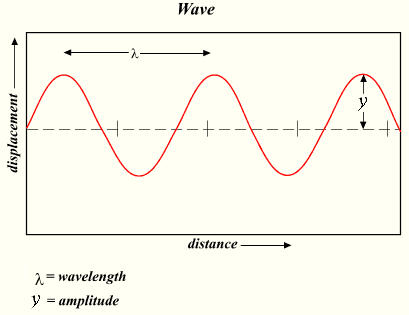
Wavelength and Amplitude : The wavelength is the distance between adjacent crests. The amplitude is the 1/2 the distance from crest to trough.
Two Types of Waves: Longitudinal vs. Transverse : Even ocean waves!
Longitudinal Waves
Longitudinal waves, sometimes called compression waves, oscillate in the direction of propagation.
- Give properties and provide examples of the longitudinal wave
Longitudinal waves have the same direction of vibration as their direction of travel. This means that the movement of the medium is in the same direction as the motion of the wave. Some longitudinal waves are also called compressional waves or compression waves. An easy experiment for observing longitudinal waves involves taking a Slinky and holding both ends. After compressing and releasing one end of the Slinky (while still holding onto the end), a pulse of more concentrated coils will travel to the end of the Slinky.
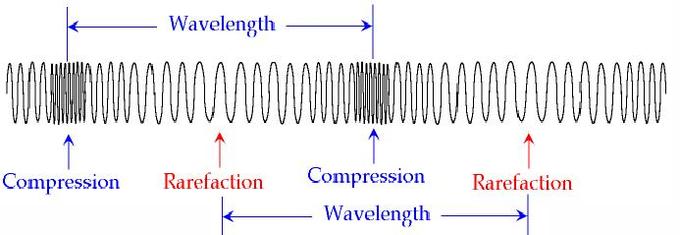
Longitudinal Waves : A compressed Slinky is an example of a longitudinal wave. The wve propagates in the same direction of oscillation.
Like transverse waves, longitudinal waves do not displace mass. The difference is that each particle which makes up the medium through which a longitudinal wave propagates oscillates along the axis of propagation. In the example of the Slinky, each coil will oscillate at a point but will not travel the length of the Slinky. It is important to remember that energy, in this case in the form of a pulse, is being transmitted and not the displaced mass.
Longitudinal waves can sometimes also be conceptualized as pressure waves. The most common pressure wave is the sound wave. Sound waves are created by the compression of a medium, usually air. Longitudinal sound waves are waves of alternating pressure deviations from the equilibrium pressure, causing local regions of compression and rarefaction. Matter in the medium is periodically displaced by a sound wave, and thus oscillates. When people make a sound, whether it is through speaking or hitting something, they are compressing the air particles to some significant amount. By doing so, they create transverse waves. When people hear sounds, their ears are sensitive to the pressure differences and interpret the waves as different tones.
Water Waves
Water waves can be commonly observed in daily life, and comprise both transverse and longitudinal wave motion.
- Describe particle movement in water waves
Water waves, which can be commonly observed in our daily lives, are of specific interest to physicists. Describing detailed fluid dynamics in water waves is beyond the scope of introductory physics courses. Although we often observe water wave propagating in 2D, in this atom we will limit our discussion to 1D propagation.
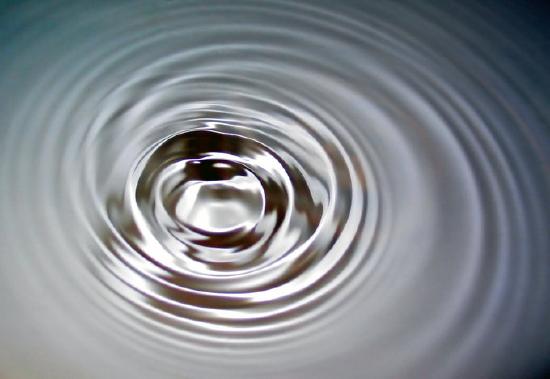
Water waves : Surface waves in water
The uniqueness of water waves is found in the observation that they comprise both transverse and longitudinal wave motion. As a result, the particles composing the wave move in clockwise circular motion, as seen in. Oscillatory motion is highest at the surface and diminishes exponentially with depth. Waves are generated by wind passing over the surface of the sea. As long as the waves propagate slower than the wind speed just above the waves, there is an energy transfer from the wind to the waves. Both air pressure differences between the upwind and the lee side of a wave crest, as well as friction on the water surface by the wind (making the water to go into the shear stress), contribute to the growth of the waves.
In the case of monochromatic linear plane waves in deep water, particles near the surface move in circular paths, creating a combination of longitudinal (back and forth) and transverse (up and down) wave motions. When waves propagate in shallow water (where the depth is less than half the wavelength ), the particle trajectories are compressed into ellipses. As the wave amplitude (height) increases, the particle paths no longer form closed orbits; rather, after the passage of each crest, particles are displaced slightly from their previous positions, a phenomenon known as Stokes drift.
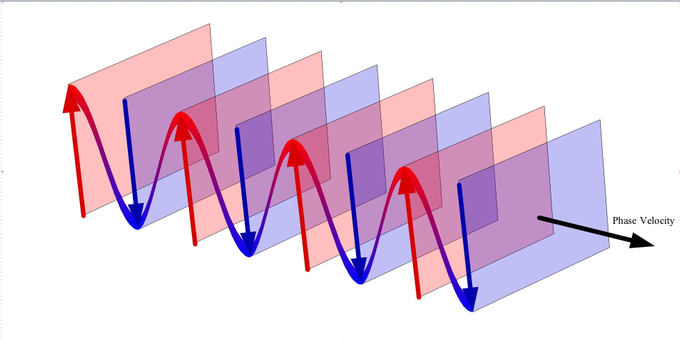
Plane wave : We see a wave propagating in the direction of the phase velocity. The wave can be thought to be made up of planes orthogonal to the direction of the phase velocity.
Since water waves transport energy, attempts to generate power from them have been made by utilizing the physical motion of such waves. Although larger waves are more powerful, wave power is also determined by wave speed, wavelength, and water density. Deep water corresponds with a water depth larger than half the wavelength, as is a common case in the sea and ocean. In deep water, longer-period waves propagate faster and transport their energy faster. The deep-water group velocity is half the phase velocity. In shallow water for wavelengths larger than about twenty times the water depth (as often found near the coast), the group velocity is equal to the phase velocity. These methods have proven viable in some cases but do not provide a fully sustainable form of renewable energy to date.
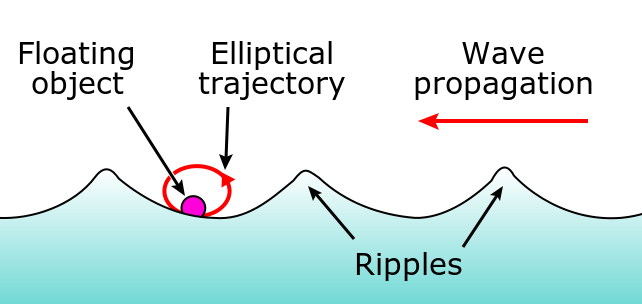
Water waves : The motion water waves causes particles to follow clockwise circular motion. This is a result of the wave having both transverse and longitudinal properties.
Wavelength, Freqency in Relation to Speed
Waves are defined by its frequency, wavelength, and amplitude among others. They also have two kinds of velocity: phase and group velocity.
- Identify major characteristic properties of waves
Characteristics of Waves
Waves have certain characteristic properties which are observable at first notice. The first property to note is the amplitude. The amplitude is half of the distance measured from crest to trough. We also observe the wavelength, which is the spatial period of the wave (e.g. from crest to crest or trough to trough). We denote the wavelength by the Greek letter λλ.
The frequency of a wave is the number of cycles per unit time — one can think of it as the number of crests which pass a fixed point per unit time. Mathematically, we make the observation that,
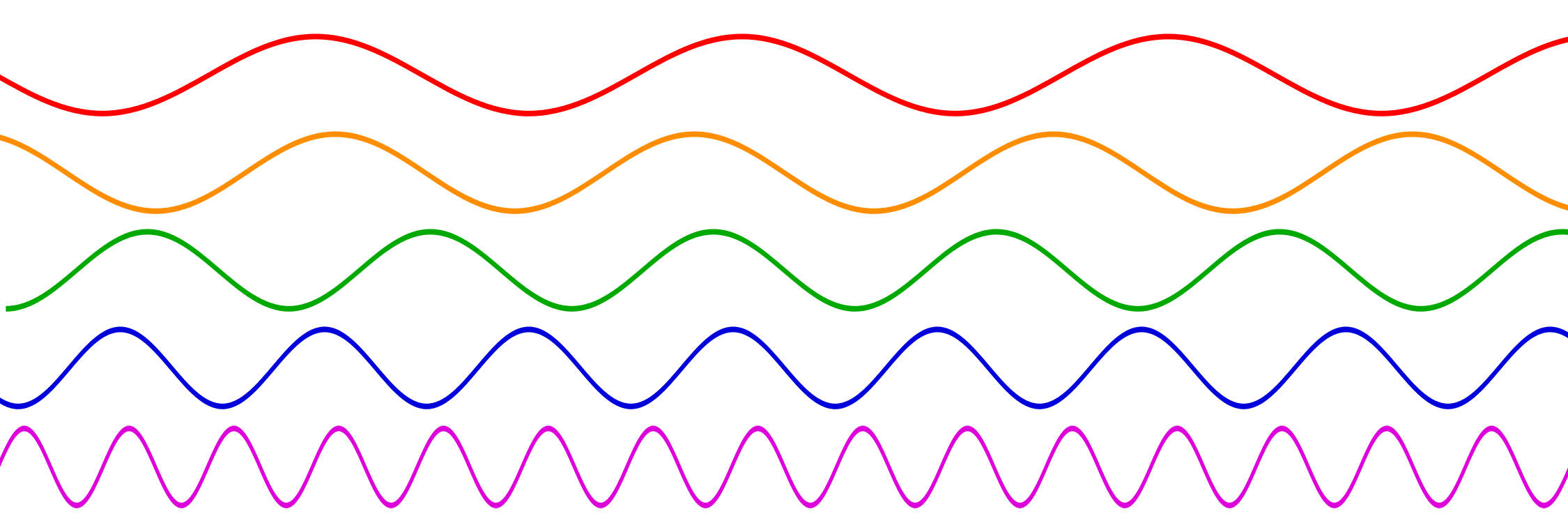
Frequencies of different sine waves. : The red wave has a low frequency sine there is very little repetition of cycles. Conversely we say that the purple wave has a high frequency. Note that time increases along the horizontal.
\[\mathrm{f=\dfrac{1}{T}}\]
where T is the period of oscillation. Frequency and wavelength can also be related-* with respects to a “speed” of a wave. In fact,
\[\mathrm{v=fλ}]
where v is called the wave speed, or more commonly,the phase velocity, the rate at which the phase of the wave propagates in space. This is the velocity at which the phase of any one frequency component of the wave travels. For such a component, any given phase of the wave (for example, the crest) will appear to travel at the phase velocity.
Finally, the group velocity of a wave is the velocity with which the overall shape of the waves’ amplitudes — known as the modulation or envelope of the wave — propagates through space. In, one may see that the overall shape (or “envelope”) propagates to the right, while the phase velocity is negative.
Fig 2 : This shows a wave with the group velocity and phase velocity going in different directions. (The group velocity is positive and the phase velocity is negative. )
Energy Transportation
Waves transfer energy which can be used to do work.
- Relate direction of energy and wave transportation
Energy transportion is essential to waves. It is a common misconception that waves move mass. Waves carry energy along an axis defined to be the direction of propagation. One easy example is to imagine that you are standing in the surf and you are hit by a significantly large wave, and once you are hit you are displaced (unless you hold firmly to your ground!). In this sense the wave has done work (it applied a force over a distance). Since work is done over time, the energy carried by a wave can be used to generate power.
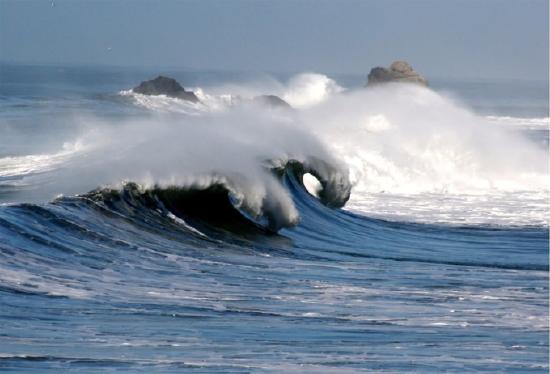
Water Wave : Waves that are more massive or have a greater velocity transport more energy.
Similarly we find that electromagnetic waves carry energy. Electromagnetic radiation (EMR) carries energy—sometimes called radiant energy—through space continuously away from the source (this is not true of the near-field part of the EM field). Electromagnetic waves can be imagined as a self-propagating transverse oscillating wave of electric and magnetic fields. EMR also carries both momentum and angular momentum. These properties may all be imparted to matter with which it interacts (through work). EMR is produced from other types of energy when created, and it is converted to other types of energy when it is destroyed. The photon is the quantum of the electromagnetic interaction, and is the basic “unit” or constituent of all forms of EMR. The quantum nature of light becomes more apparent at high frequencies (or high photon energy). Such photons behave more like particles than lower-frequency photons do.
Electromagnetic Wave : Electromagnetic waves can be imagined as a self-propagating transverse oscillating wave of electric and magnetic fields. This 3D diagram shows a plane linearly polarized wave propagating from left to right.
In general, there is a relation of waves which states that the velocity (\(\mathrm{v}\)) of a wave is proportional to the frequency (\(\mathrm{f}\)) times the wavelength (\(\mathrm{λ}\)):
We also know that classical momentum pp is given by p=mvp=mv which relates to force via Newton’s second law: \(\mathrm{F=\dfrac{dp}{dt}}\)
EM waves with higher frequencies carry more energy. This is a direct result of the equations above. Since \(\mathrm{v∝f}\) we find that higher frequencies imply greater velocity. If velocity is increased then we have greater momentum which implies a greater force (it gets a little bit tricky when we talk about particles moving close to the speed of light, but this observation holds in the classical sense). Since energy is the ability of an object to do work, we find that for \(\mathrm{W=Fd}\) a greater force correlates to more energy transfer. Again, this is an easy phenomenon to experience empirically; just stand in front of a faster wave and feel the difference!
- A wave can be thought of as a disturbance or oscillation that travels through space-time, accompanied by a transfer of energy.
- The direction a wave propagates is perpendicular to the direction it oscillates for transverse waves.
- A wave does not move mass in the direction of propagation; it transfers energy.
- Transverse waves oscillate in the z-y plane but travel along the x axis.
- A transverse wave has a speed of propagation given by the equation \(\mathrm{v = fλ}\).
- The direction of energy transfer is perpendicular to the motion of the wave.
- While longitudinal waves oscillate in the direction of propagation, they do not displace mass since the oscillations are small and involve an equilibrium position.
- The longitudinal ‘waves’ can be conceptualized as pulses that transfer energy along the axis of propagation.
- Longitudinal waves can be conceptualized as pressure waves characterized by compression and rarefaction.
- The particles which make up a water wave move in circular paths.
- If the waves move slower than the wind above them, energy is transfered from the wind to the waves.
- The oscillations are greatest on the surface of the wave and become weaker deeper in the fluid.
- The wavelength is the spatial period of the wave.
- The frequency of a wave refers to the number of cycles per unit time and is not to be confused with angular frequency.
- The phase velocity can be expressed as the product of wavelength and frequency.
- Waves which are more massive transfer more energy.
- Waves with greater velocities transfer more energy.
- Energy of a wave is transported in the direction of the waves transportation.
- medium : The material or empty space through which signals, waves or forces pass.
- direction of propagation : The axis along which the wave travels.
- wave : A moving disturbance in the energy level of a field.
- wavelength : The length of a single cycle of a wave, as measured by the distance between one peak or trough of a wave and the next; it is often designated in physics as λ, and corresponds to the velocity of the wave divided by its frequency.
- trough : A long, narrow depression between waves or ridges.
- speed of propagation : The speed at which a wave moves through a medium.
- crest : The ridge or top of a wave.
- transverse wave : Any wave in which the direction of disturbance is perpendicular to the direction of travel.
- rarefaction : a reduction in the density of a material, especially that of a fluid
- Longitudinal : Running in the direction of the long axis of a body.
- compression : to increase in density; the act of compressing, or the state of being compressed; compaction
- phase velocity : The velocity of propagation of a pure sine wave of infinite extent and infinitesimal amplitude.
- group velocity : The propagation velocity of the envelope of a modulated travelling wave, which is considered as the propagation velocity of information or energy contained in it.
- plane wave : A constant-frequency wave whose wavefronts (surfaces of constant phase) are infinite parallel planes of constant peak-to-peak amplitude normal to the phase velocity vector.
- wave speed : The absolute value of the velocity at which the phase of any one frequency component of the wave travels.
- frequency : The quotient of the number of times n a periodic phenomenon occurs over the time t in which it occurs: \(\mathrm{f = \frac{n}{t}}\).
- energy : A quantity that denotes the ability to do work and is measured in a unit dimensioned in mass × distance²/time² (ML²/T²) or the equivalent.
- power : A measure of the rate of doing work or transferring energy.
- work : A measure of energy expended in moving an object; most commonly, force times displacement. No work is done if the object does not move.
LICENSES AND ATTRIBUTIONS
CC LICENSED CONTENT, SHARED PREVIOUSLY
- Curation and Revision. Provided by : Boundless.com. License : CC BY-SA: Attribution-ShareAlike
CC LICENSED CONTENT, SPECIFIC ATTRIBUTION
- Waves. Provided by : Wikipedia. Located at : en.Wikipedia.org/wiki/Waves . License : CC BY-SA: Attribution-ShareAlike
- Wave. Provided by : Wikipedia. Located at : en.Wikipedia.org/wiki/Wave . License : CC BY-SA: Attribution-ShareAlike
- direction of propagation. Provided by : Wikipedia. Located at : en.Wikipedia.org/wiki/direction%20of%20propagation . License : CC BY-SA: Attribution-ShareAlike
- wave. Provided by : Wiktionary. Located at : en.wiktionary.org/wiki/wave . License : CC BY-SA: Attribution-ShareAlike
- medium. Provided by : Wiktionary. Located at : en.wiktionary.org/wiki/medium . License : CC BY-SA: Attribution-ShareAlike
- Simple harmonic motion animation. Provided by : Wikipedia. Located at : en.Wikipedia.org/wiki/File:Simple_harmonic_motion_animation.gif . License : Public Domain: No Known Copyright
- The Wave Equation. Located at : http://www.youtube.com/watch?v=jEEPp0mBCdg . License : Public Domain: No Known Copyright . License Terms : Standard YouTube license
- crest. Provided by : Wiktionary. Located at : en.wiktionary.org/wiki/crest . License : CC BY-SA: Attribution-ShareAlike
- Transverse wave. Provided by : Wikipedia. Located at : en.Wikipedia.org/wiki/Transverse_wave . License : CC BY-SA: Attribution-ShareAlike
- Boundless. Provided by : Boundless Learning. Located at : www.boundless.com//physics/definition/speed-of-propagation . License : CC BY-SA: Attribution-ShareAlike
- wavelength. Provided by : Wiktionary. Located at : en.wiktionary.org/wiki/wavelength . License : CC BY-SA: Attribution-ShareAlike
- trough. Provided by : Wiktionary. Located at : en.wiktionary.org/wiki/trough . License : CC BY-SA: Attribution-ShareAlike
- transverse wave. Provided by : Wiktionary. Located at : en.wiktionary.org/wiki/transverse_wave . License : CC BY-SA: Attribution-ShareAlike
- Wave. Provided by : Wikipedia. Located at : simple.Wikipedia.org/wiki/File:Wave.png . License : Public Domain: No Known Copyright
- Two Types of Waves: Longitudinal vs. Transverse. Located at : http://www.youtube.com/watch?v=PxB8-BVO82g . License : Public Domain: No Known Copyright . License Terms : Standard YouTube license
- ComplexSinInATimeAxe. Provided by : Wikipedia. Located at : en.Wikipedia.org/wiki/File:ComplexSinInATimeAxe.gif . License : Public Domain: No Known Copyright
- Longitudinal wave. Provided by : Wikipedia. Located at : en.Wikipedia.org/wiki/Longitudinal_wave . License : CC BY-SA: Attribution-ShareAlike
- Sound waves. Provided by : Wikipedia. Located at : en.Wikipedia.org/wiki/Sound_waves%23Longitudinal_and_transverse_waves . License : CC BY-SA: Attribution-ShareAlike
- Longitudinal. Provided by : Wiktionary. Located at : en.wiktionary.org/wiki/Longitudinal . License : CC BY-SA: Attribution-ShareAlike
- compression. Provided by : Wiktionary. Located at : en.wiktionary.org/wiki/compression . License : CC BY-SA: Attribution-ShareAlike
- rarefaction. Provided by : Wiktionary. Located at : en.wiktionary.org/wiki/rarefaction . License : CC BY-SA: Attribution-ShareAlike
- funwaves - 5.nLongitudinal wave. Provided by : Wikispaces. Located at : http://funwaves.wikispaces.com/5.+Longitudinal+wave . License : CC BY-SA: Attribution-ShareAlike
- Wave power. Provided by : Wikipedia. Located at : en.Wikipedia.org/wiki/Wave_power . License : CC BY-SA: Attribution-ShareAlike
- Wind wave. Provided by : Wikipedia. Located at : en.Wikipedia.org/wiki/Wind_wave . License : CC BY-SA: Attribution-ShareAlike
- Wave power. Provided by : Wikipedia. Located at : http://en.Wikipedia.org/wiki/Wave_power . License : CC BY-SA: Attribution-ShareAlike
- plane wave. Provided by : Wikipedia. Located at : en.Wikipedia.org/wiki/plane%20wave . License : CC BY-SA: Attribution-ShareAlike
- phase velocity. Provided by : Wiktionary. Located at : en.wiktionary.org/wiki/phase_velocity . License : CC BY-SA: Attribution-ShareAlike
- group velocity. Provided by : Wiktionary. Located at : en.wiktionary.org/wiki/group_velocity . License : CC BY-SA: Attribution-ShareAlike
- Wave. Provided by : Wikipedia. Located at : en.Wikipedia.org/wiki/Wave . License : CC BY: Attribution
- Plane Wave Oblique View. Provided by : Wikimedia. Located at : commons.wikimedia.org/wiki/File:Plane_Wave_Oblique_View.jpg . License : Public Domain: No Known Copyright
- Elliptical trajectory on ripples. Provided by : Wikipedia. Located at : en.Wikipedia.org/wiki/File:Elliptical_trajectory_on_ripples.svg . License : Public Domain: No Known Copyright
- Frequency. Provided by : Wikipedia. Located at : en.Wikipedia.org/wiki/Frequency . License : CC BY-SA: Attribution-ShareAlike
- Phase velocity. Provided by : Wikipedia. Located at : en.Wikipedia.org/wiki/Phase_velocity . License : CC BY-SA: Attribution-ShareAlike
- Group velocity. Provided by : Wikipedia. Located at : en.Wikipedia.org/wiki/Group_velocity . License : CC BY-SA: Attribution-ShareAlike
- wave speed. Provided by : Wikipedia. Located at : en.Wikipedia.org/wiki/wave%20speed . License : CC BY-SA: Attribution-ShareAlike
- frequency. Provided by : Wiktionary. Located at : en.wiktionary.org/wiki/frequency . License : CC BY-SA: Attribution-ShareAlike
- Group velocity. Provided by : Wikipedia. Located at : en.Wikipedia.org/wiki/Group_velocity . License : CC BY: Attribution
- Sine waves different frequencies. Provided by : Wikipedia. Located at : en.Wikipedia.org/wiki/File:Sine_waves_different_frequencies.svg . License : Public Domain: No Known Copyright
- Electromagnetic radiation. Provided by : Wikipedia. Located at : en.Wikipedia.org/wiki/Electromagnetic_radiation . License : CC BY-SA: Attribution-ShareAlike
- Electromagnetic radiation. Provided by : Wikipedia. Located at : http://en.Wikipedia.org/wiki/Electromagnetic_radiation . License : CC BY-SA: Attribution-ShareAlike
- energy. Provided by : Wiktionary. Located at : en.wiktionary.org/wiki/energy . License : CC BY-SA: Attribution-ShareAlike
- work. Provided by : Wiktionary. Located at : en.wiktionary.org/wiki/work . License : CC BY-SA: Attribution-ShareAlike
- Boundless. Provided by : Boundless Learning. Located at : www.boundless.com//sociology/definition/power . License : CC BY-SA: Attribution-ShareAlike
- Wave. Provided by : Wikipedia. Located at : http://simple.Wikipedia.org/wiki/File:Wave.png . License : Public Domain: No Known Copyright
- ComplexSinInATimeAxe. Provided by : Wikipedia. Located at : http://en.Wikipedia.org/wiki/File:ComplexSinInATimeAxe.gif . License : Public Domain: No Known Copyright
- Elliptical trajectory on ripples. Provided by : Wikipedia. Located at : http://en.Wikipedia.org/wiki/File:Elliptical_trajectory_on_ripples.svg . License : Public Domain: No Known Copyright
- Waves in pacifica 1. Provided by : Wikipedia. Located at : en.Wikipedia.org/wiki/File:Waves_in_pacifica_1.jpg . License : Public Domain: No Known Copyright
- Electromagneticwave3Dfromside. Provided by : Wikipedia. Located at : en.Wikipedia.org/wiki/File:Electromagneticwave3Dfromside.gif . License : CC BY: Attribution
Exploring Our Fluid Earth
Teaching science as inquiry.
- Create new account
- Reset your password
For more option use Advanced Search
Wave Energy and Wave Changes with Depth
Wave energy.
Many forms of energy are carried in heat, light, sound, and water waves. Energy is defined as the ability to do work; all forms of energy can be transformed into work. In science, work is defined as the movement of an object in the direction of the force applied to it. Waves do work when they move objects. We can see this work when heavy logs move across ocean basins or sand is transported. Work can also be converted into sound energy heard when waves crash on the shore. The powerful energy in waves can also be used to do work by moving generator parts to produce electricity.
Ocean waves carry huge amounts of energy. The amount of energy can be measured in joules (J) of work, calories (c) of heat, or kilowatt-hours (kWh) of electricity (Table 4.8). The standard measurement of energy in science is the joule.
The amount of energy in a wave depends on its height and wavelength as well as the distance over which it breaks. Given equal wavelengths, a wave with greater amplitude will release more energy when it falls back to sea level than a wave of lesser amplitude. Energy (E) per square meter is proportional to the square of the height (H): E∝H 2 . In other words, if wave A is two times the height of wave B, then wave A has four times the energy per square meter of water surface as wave B.

Fig. 4.17. Energy comparison between a wave with a height of 2 m and a wavelength of 14 m breaking over 2 km, a gallon of gasoline, and an average home’s daily use shows that the three are relatively equivalent.
Image by Byron Inouye
A wave with a height of 2 m and a wavelength of 14 m breaking along 2 km of coastline (surface area = 32,000 m 2 ) has approximately 45 kWh of energy. This is roughly equivalent to one gallon of gasoline, which contains about 160 million (1.6 x 10 8 ) joules (J) of energy. According to the US Department of Agriculture, the World Bank, and the US Energy Information Administration, the average American eats 3.14 kWh per day in food, uses about 37 kWh in electricity, and uses a combined 250 kWh per day in electricity and petroleum. This means that the energy in one 2 m by 14 m by 2 km wave is equivalent to the amount of energy needed to feed a person for two weeks, power their home for one day, or power their electrical and transportation needs for 5 hours (Fig. 4.17). Ocean waves offer a very large source of renewable energy. Technologies that efficiently harvest this energy resource are actively being researched and developed by scientists.
Orbital Motion of Waves
By watching a buoy anchored in a wave zone one can see how water moves in a series of waves. The passing swells do not move the buoy toward shore; instead, the waves move the buoy in a circular fashion, first up and forward, then down, and finally back to a place near the original position. Neither the buoy nor the water advances toward shore.
As the energy of a wave passes through water, the energy sets water particles into orbital motion as shown in Fig. 4.18 A. Notice that water particles near the surface move in circular orbits with diameters approximately equal to the wave height. Notice also that the orbital diameter, and the wave energy, decreases deeper in the water. Below a depth of half the wavelength (D = 1/2 L), water is unaffected by the wave energy.
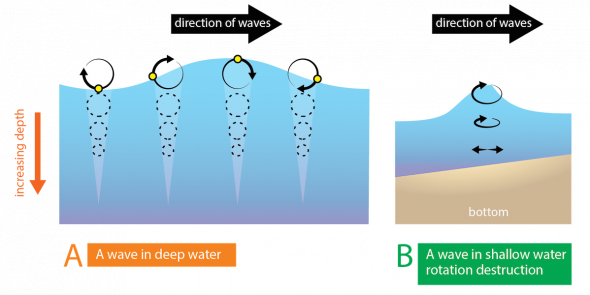
Fig. 4.18. ( A ) If a small buoy (black circle) was on the surface of the water, it would move in a circular motion, returning to its original location due to the orbital motion of waves in deep water. ( B ) As deep-water waves approach shore and become shallow-water waves, circular motion is distorted as interaction with the bottom occurs.
Deep-Water, Transitional, and Shallow-Water Waves
Swells are deep-water waves , meaning that the depth (D) of the water is greater than half the wave’s wavelength (D > 1/2 L). The energy of a deep-water wave does not touch the bottom in the open water (Fig. 4.18 A).
When deep-water waves move into shallow water, they change into breaking waves. When the energy of the waves touches the ocean floor, the water particles drag along the bottom and flatten their orbit (Fig. 4.18 B).
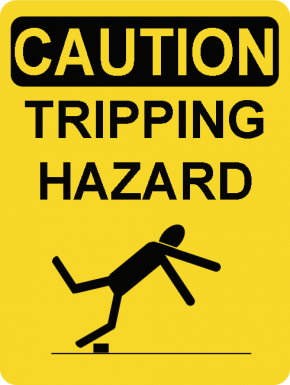
Fig. 4.19. The action of someone tripping is similar to the interaction between a shallow-water wave and the bottom of the ocean
Image by Alyssa Gundersen
Transitional waves occur when the water depth is less than one-half the wavelength (D < 1/2 L). At this point the water movement of particles on the surface transitions from swells to steeper waves called peaking waves (Fig. 4.19). Because of the friction of the deeper part of the wave with particles on the bottom, the top of the wave begins to move faster than the deeper parts of the wave. When this happens, the front surface of the wave gradually becomes steeper than the back surface.
When the water depth is less than one-twentieth the wavelength, the wave becomes a shallow-water wave (D < 1/20 L). At this point, the top of the wave travels so much faster than the bottom of the wave that top of the wave begins to spill over and fall down the front surface. This is called a breaking wave . A breaking wave occurs when one of three things happen:
- The crest of the wave forms an angle less than 120˚,
- The wave height is greater than one-seventh of the wavelength (H > 1/7 L), or
- The wave height is greater than three-fourths of the water depth (H > 3/4 D).
In some ways a breaking wave is similar to what happens when a person trips and falls. As a person walks normally, their feet and head are traveling forward at the same rate. If their foot catches on the ground, then the bottom part of their body is slowed by friction, while the top part continues at a faster speed (see Fig. 4.19). If the person’s foot continues to lag far behind their upper body, the angle of their body will change and they will topple over.
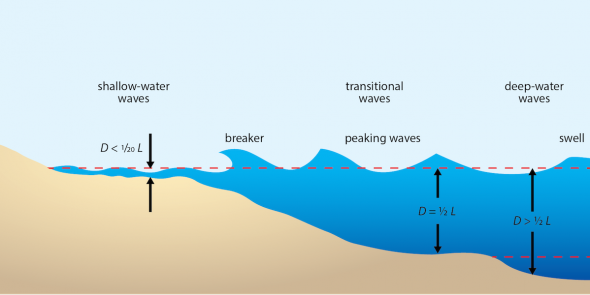
Fig. 4.20. Waves change as they approach the shore.
The transition of a wave from a deep-water wave to a shallow-water breaking wave is shown in Fig. 4.20. Terms relating to wave depth a described in detail in Table 4.9.
Observe orbital motion of waves in a long wave tank.
Simulate Deep-Water, Transitional, and Shallow-Water Waves
Use a long wave tank to create and observe the differences between deep-water, transitional, and shallow-water waves.

Authors & Partners
Partner Organizations

Exploring Our Fluid Earth, a product of the Curriculum Research & Development Group (CRDG), College of Education. © University of Hawai‘i, . This document may be freely reproduced and distributed for non-profit educational purposes.

- school Campus Bookshelves
- menu_book Bookshelves
- perm_media Learning Objects
- login Login
- how_to_reg Request Instructor Account
- hub Instructor Commons
- Download Page (PDF)
- Download Full Book (PDF)
- Periodic Table
- Physics Constants
- Scientific Calculator
- Reference & Cite
- Tools expand_more
- Readability
selected template will load here
This action is not available.

10.3: Wave Orbits and Orbital Depth
- Last updated
- Save as PDF
- Page ID 10306

- Miracosta Oceanography 101
Wave Orbits and Orbital Depth
Passing waves create a circular current in the water. This is revealed by the orbit-like motion of particles in the water. The orbital motion of a wave is greatest at the surface and diminishes with depth. Orbital depth is the depth to which the orbital motion of the wave energy can be felt. Orbital depth is equal to half of the wavelength . At the sea surface, orbital diameter is equal to wave height. As depth increases, less wave energy can be felt. The orbital depth is the depth where zero wave energy remains. For example, if a wave at the surface has a height of 4 meters and a wavelength of 48 m, then the depth where no motion from the wave exists is 48/2 or 24 meters.
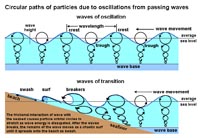
Deep-Water Waves and Shallow-Water Waves
The depth of the water determines the character of wave behaviors.
- Deep-water waves are waves passing through water greater than half of its wavelength . Deep-water waves are waves of oscillation . A wave of oscillation is a wave in the open ocean where movement in the water below a passing wave is in a vertical circular motion.
- Shallow-water waves are waves that are interacting with the seabed in depths less than half it wavelength. Shallow-water waves are called waves of transition because they change character as the move shoreward and dissipate their energy interacting with the seabed onto the shore.
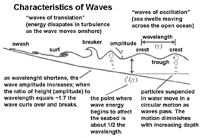
Wind waves change as they approach the shore:
- As a wave approaches shallow water its begins to transform when it's orbital depth comes in contact with the seabed (when d < L/2).
- The friction caused by waves interacting with the seabed causes waves to slow down as the move onshore.
- The friction of the seabed begins to slow the bottom of the wave; whereas the top of the wave does not slow as quickly..
- Circular motion within the wave becomes interrupted and becomes elliptical.
- As waves approach the beach, their wavelengths (L) and velocity decrease. However the period (T) stays the same. The shortening of the wavelength results in an increase in wave height as it moves into shallow water.
- A wave breaks when the water depth (d) is about the same as the wave height (h). Where a wave curls over on itself is called a breaker .
- Breakers then turn into a turbulent front called surf that moves onto the beach.
- When the dying wave runs up on the beach and then retreats it is called swash .
GCSEPhysicsNinja.com
Smarter teaching – smarter learning.

43. Water waves in shallow and deep water

Water waves moving from shallow to deeper water
Light waves will speed up or slow down when they enter or exit a material of a different optical density, which is the refractive index of the material. If the refractive index of the material is higher than the refractive index of air (which has the value of 1.0), then light will travel slower in the material.
However, water waves are a bit different because these waves are mechanical waves - it's the oscillations of actual water molecules which cause the wave to move. Water waves are actually called 'Rayleigh waves'. For GCSE purposes we treat them as being transverse waves, but they're actually more complex than that - here's an animation:
If you look at a particle closely, you'll see that it oscillates both perpendicular and parallel to the direction of the wave motion. So a Rayleigh wave is a mixture of a longitudinal and a transverse wave!
The depth of water affects the speed of these waves directly without having anything to do with the density of the water. The deeper the water, the faster the waves travel, and so waves will refract (change direction) when they enter deeper or shallower water at an angle.
GCSE Keywords: water waves, shallow, deep, wave speed, wavelength, direction
Course overview
Privacy Overview

Want to create or adapt books like this? Learn more about how Pressbooks supports open publishing practices.
51 Deep- and shallow-water waves
Ocean surface waves have a dispersion relationship with a wave speed that is, in general, dependent on wavelength,
such that these waves are in general dispersive. (You are not responsible for the derivation of this expression , just for understanding its implications.) This dispersive behavior, where longer wavelength waves travel faster than shorter wavelength waves, is familiar if you have observed ripples spreading outward from a stone cast into a pond (watch the following YouTube video if you can’t remember what that looks like!) These ripples occur in water that is deep relative to their wavelength.
However, when the water is shallow relative to the wavelength of the wave, the waves become nondispersive. Tsunamis are an example of such long wavelength waves, but even waves created by storms can become nondispersive when they approach the shoreline and enter shallow water.
We start to understand this different behavior in deep vs. shallow water by taking a look at the hyperbolic tangent function
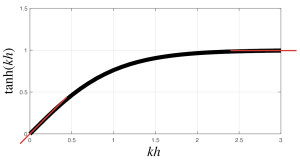
These waves are called shallow water waves.
These waves are called deep water waves.
Media Attributions
- tanh © Susan Hautala is licensed under a CC BY-NC-SA (Attribution NonCommercial ShareAlike) license
Physics Across Oceanography: Fluid Mechanics and Waves Copyright © 2020 by Susan Hautala is licensed under a Creative Commons Attribution-NonCommercial-ShareAlike 4.0 International License , except where otherwise noted.
Share This Book

Want to create or adapt books like this? Learn more about how Pressbooks supports open publishing practices.
10.1 Wave Basics
Waves generally begin as a disturbance of some kind, and the energy of that disturbance gets propagated in the form of waves. We are most familiar with the kind of waves that break on shore, or rock a boat at sea, but there are many other types of waves that are important to oceanography:
- Internal waves form at the boundaries of water masses of different densities (i.e. at a pycnocline ), and propagate at depth. These generally move more slowly than surface waves, and can be much larger, with heights exceeding 100 m. However, the height of the deep wave would be unnoticeable at the surface.
- Tidal waves are due to the movement of the tides. What we think of as tides are basically enormously long waves with a wavelength that may span half the globe (see section 11.1 ). Tidal waves are not related to tsunamis , so don’t confuse the two.
- Tsunamis are large waves created as a result of earthquakes or other seismic disturbances. They are also called seismic sea waves ( section 10.4 ).
- Splash waves are formed when something falls into the ocean and creates a splash. The giant wave in Lituya Bay that was described in the introduction to this chapter was a splash wave.
- Atmospheric waves form in the sky at the boundary between air masses of different densities. These often create ripple effects in the clouds (Figure 10.1.1).
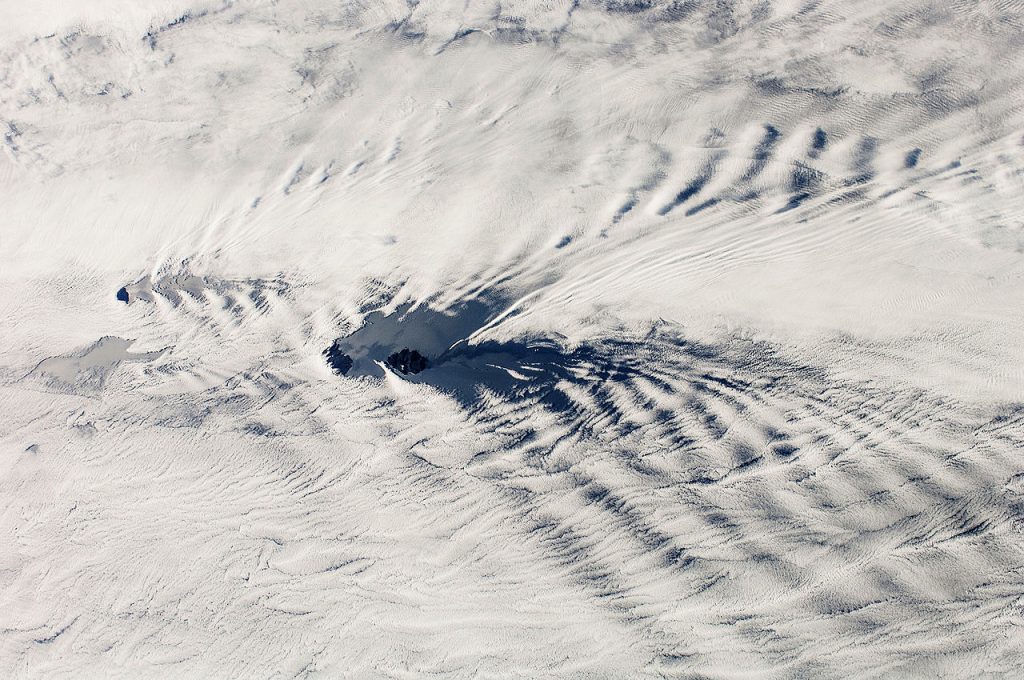
There are several components to a basic wave (Figure 10.1.2):
- Still water level: where the water surface would be if there were no waves present and the sea was completely calm.
- Crest: the highest point of the wave.
- Trough: the lowest point of the wave.
- Wave height: the distance between the crest and the trough.
- Wavelength: the distance between two identical points on successive waves, for example crest to crest, or trough to trough.
- Wave steepness: the ratio of wave height to length (H/L). If this ratio exceeds 1/7 (i.e. height exceeds 1/7 of the wavelength) the wave gets too steep, and will break.

There are also a number of terms used to describe wave motion:
- Period: the time it takes for two successive crests to pass a given point.
- Frequency: the number of waves passing a point in a given amount of time, usually expressed as waves per second. This is the inverse of the period.
- Speed : how fast the wave travels, or the distance traveled per unit of time. This is also called celerity (c), where
c = wavelength x frequency
Therefore, the longer the wavelength , the faster the wave.
Although waves can travel over great distances, the water itself shows little horizontal movement; it is the energy of the wave that is being transmitted, not the water. Instead, the water particles move in circular orbits, with the size of the orbit equal to the wave height (Figure 10.1.3). This orbital motion occurs because water waves contain components of both longitudinal (side to side) and transverse (up and down) waves, leading to circular motion. As a wave passes, water moves forwards and up over the wave crests , then down and backwards into the troughs , so there is little horizontal movement. This is evident if you have ever watched an object such as a seabird floating at the surface. The bird bobs up and down as the wave pass underneath it; it does not get carried horizontally by a single wave crest.
The circular orbital motion declines with depth as the wave has less impact on deeper water and the diameter of the circles is reduced. Eventually at some depth there is no more circular movement and the water is unaffected by surface wave action. This depth is the wave base and is equivalent to half of the wavelength (Figure 10.1.4). Since most ocean waves have wavelengths of less than a few hundred meters, most of the deeper ocean is unaffected by surface waves, so even in the strongest storms marine life or submarines can avoid heavy waves by submerging below the wave base.
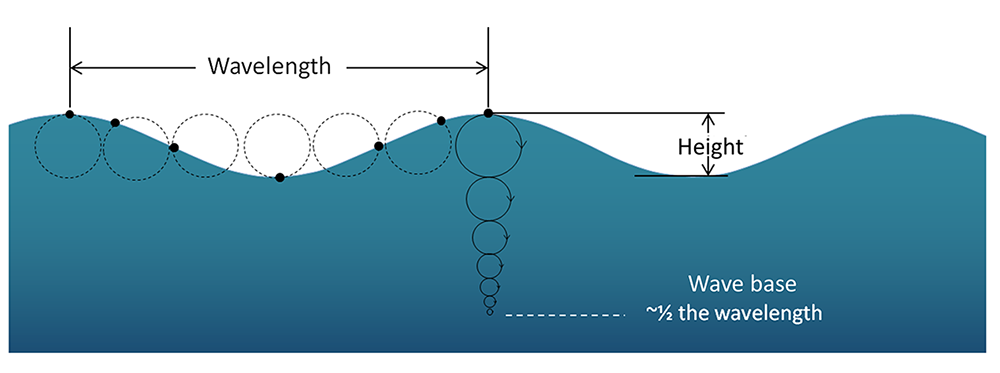
When the water below a wave is deeper than the wave base (deeper than half of the wavelength), those waves are called deep water waves . Most open ocean waves are deep water waves. Since the water is deeper than the wave base, deep water waves experience no interference from the bottom, so their speed only depends on the wavelength:
where g is gravity and L is wavelength in meters. Since g and π are constants, this can be simplified to:
Shallow water waves occur when the depth is less than 1/20 of the wavelength. In these cases, the wave is said to “touch bottom” because the depth is shallower than the wave base so the orbital motion is affected by the seafloor. Due to the shallow depth, the orbits are flattened, and eventually the water movement becomes horizontal rather than circular just above the bottom. The speed of shallow water waves depends only on the depth:
where g is gravity and d is depth in meters. This can be simplified to:
Intermediate or transitional waves are found in depths between ½ and 1/20 of the wavelength. Their behavior is a bit more complex, as their speed is influenced by both wavelength and depth. The speed of an intermediate wave is calculated as:
which contains both depth and wavelength variables.
a volume of seawater with a distinctive density as a result of its unique profile of temperature and salinity (9.8)
a region in the water column where there is a large change in density over a small change in depth (6.3)
the distance between the crests of two waves (10.1)
a long-wavelength wave produced by the vertical motion of the floor of the ocean, typically related either to an earthquake or other submarine seismic event (10.1)
the speed of a wave (10.1)
the distance between the crest and trough of a wave (10.1)
the highest point on a wave (10.1)
the lowest point of a wave (10.1)
the depth of water that is affected by the sub-surface orbital motion of wave action (approximately one-half of the wavelength) (10.1)
a wave above a water depth greater than half of its wavelength (10.1)
a wave in water with a depth less than 1/20 of the wavelength (10.1)
a wave in a water depth between 1/2 and 1/20 its wavelength (10.1)
Introduction to Oceanography Copyright © by Paul Webb is licensed under a Creative Commons Attribution 4.0 International License , except where otherwise noted.
Share This Book

- Username Password Remember me Sign in New here ? Join Us

- Surface waves travel...
Surface waves travelling in deep water at 15ms-1 are incident at a shallow water boundary....
- A. 8.1ms -1
- B. 10.0ms -1
- C. 10.6ms -1
- D. 22.5ms -1

Correct Answer: Option C
Explanation, contributions ({{ comment_count }}), please wait..., modal title, {{ feedback_modal_data.title }}, quick questions.

Post your Contribution
Please don't post or ask to join a "Group" or "Whatsapp Group" as a comment. It will be deleted. To join or start a group, please click here
{{ quote.posted_by.display_name }}
Linear Waves on Shallow Water Slowing Down near the Shore over Uneven Bottom
- Published: 08 May 2024
- Volume 59 , pages 260–269, ( 2024 )
Cite this article

- I. E. Melnikov 1 &
- E. N. Pelinovsky 2
The exact solutions to the system of equations of the linear theory of shallow water that represent travelling waves with some specific properties on the time propagation interval are discussed. These solutions are infinite when approaching the shore and finite when leaving for deep water. The solutions are obtained by reducing one-dimensional equations of shallow water to the Euler-Poisson-Darboux equation with negative integer coefficient ahead of the lower derivative. An analysis of the wave field dynamics is carried out. It is shown that the shape of a wave approaching the shore will be differentiated a certain number of times. This is illustrated by a number of examples. When the wave moves away from the shore, its profile is integrated. The solutions obtained within the framework of linear theory are valid only on a finite interval of variation in the depth.
This is a preview of subscription content, log in via an institution to check access.
Access this article
Price includes VAT (Russian Federation)
Instant access to the full article PDF.
Rent this article via DeepDyve
Institutional subscriptions
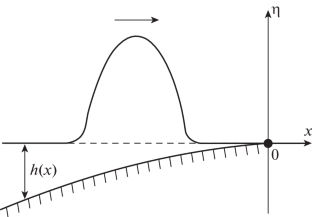
Mei, C.C., The Applied Dynamics of Ocean Surface Waves, Singapore: World Scientific, 1989.
Google Scholar
Brekhovskikh, L.M., Waves in Layered Media, Cambridge Univ. Press, 1976.
Dingemans, M.W., Water Wave Propagation over Uneven Bottom, Singapore: World Scientific, 1997.
Book Google Scholar
Kravtsov, Y.A. and Orlov, Y.I., Geometrical Optics of Inhomogeneous Media, N.Y.: Springer, 1990.
Babich, V.M. and Buldyrev, V.S., Asymptotic Methods in Short-Wavelength Diffraction Theory, Alpha Sci., 2009.
Kaptsov, O.V. and Kaptsov, D.O., Solutions of some wave models of mechanics, Prikl. Mat. Mekh. , 2023, vol. 87, no. 2, pp. 176–185.
Polyanin, A.D. and Zaitsev, V.F., Spravochnik po nelineinym uravneniyam matematicheskoi fiziki: tochnye resheniya (Handbook of Nonlinear Equations of Mathematical Physics: Exact Solutions), Moscow: FIZMATLIT, 2002.
Zaitsev, V.F. and Polyanin, A.D. Exact solutions and transformations of nonlinear heat and wave equations, Dokl. Math. , 2001, vol. 64, no. 3, pp. 416–420.
Didenkulova, I.I., Pelinovsky, E.N., and Soomere, T., Long surface wave dynamics along a convex bottom, J. Geophys. Res ., 2008, vol. 114, no. C7.
Didenkulova, I.I. and Pelinovsky, E.N., Travelling water waves along a quartic bottom profile, Proc. Estonian Acad. Sci ., 2010, vol. 59, no. 2, pp. 166–171. https://doi.org/10.3176/proc.2010.2.16
Article MathSciNet Google Scholar
Didenkulova, I.I., Pelinovsky, D.E., Tyugin, D.Y., Giniyatullin, A.R., and Pelinovsky, E.N., Travelling long waves in water rectangular channels of variable cross section, Geogr. Environ. and Liv. Syst ., 2012, no. 5, pp. 89–93.
Pelinovsky, E.N., Didenkulova, I.I., and Shurgalina E.G., Wave dynamics in variable cross-section channels, Mors. Gidr. Zh., 2017, no. 3, pp. 22–31.
Pelinovsky, E.N. and Kaptsov, O.V., Traveling waves in shallow seas of variable depths, Symm ., 2022, vol. 14, no. 7, p. 1448.
Article ADS Google Scholar
Melnikov, I.E. and Pelinovsky, E.N., Euler-Darboux-Poisson equation in context of the traveling waves in strongly inhomogeneous media, Math ., 2023, vol. 11, no. 15, p. 3309. https://doi.org/10.3390/math11153309
Article Google Scholar
Euler, L., Integral’noe ischislenie (Integral Calculus), vol. 3, Moscow: GIFML, 1958.
Kaptsov, O.V., Equivalence of linear partial differential equations and Euler–Darboux transformations, Comput. Technol ., 2007, vol. 12, no. 4 pp. 59–72.
Copson, E.T., Partial Differential Equations , Cambridge Univ. Press, 1975.
Didenkulova, I.I., New trends in the analytical theory of long sea wave runup, in: Appl. Wave Math. Spring , 2009, pp. 265–296.
Download references
The work was carried out with support from the Russian Science Foundation (grant no. 23-77-01074).
Author information
Authors and affiliations.
National Research University “Higher School of Economics”, Nizhny Novgorod, Russia
I. E. Melnikov
Gaponov–Grekhov Institute of Applied Physics of the Russian Academy of Sciences, Nizhny Novgorod, Russia
E. N. Pelinovsky
You can also search for this author in PubMed Google Scholar
Corresponding authors
Correspondence to I. E. Melnikov or E. N. Pelinovsky .

Ethics declarations
The authors of this work declare that they have no conflicts of interest.
Additional information
Translated by E.A. Pushkar
Publisher’s Note.
Pleiades Publishing remains neutral with regard to jurisdictional claims in published maps and institutional affiliations.
Rights and permissions
Reprints and permissions
About this article
Melnikov, I.E., Pelinovsky, E.N. Linear Waves on Shallow Water Slowing Down near the Shore over Uneven Bottom. Fluid Dyn 59 , 260–269 (2024). https://doi.org/10.1134/S0015462823603066
Download citation
Received : 10 October 2023
Revised : 15 December 2023
Accepted : 23 December 2023
Published : 08 May 2024
Issue Date : April 2024
DOI : https://doi.org/10.1134/S0015462823603066
Share this article
Anyone you share the following link with will be able to read this content:
Sorry, a shareable link is not currently available for this article.
Provided by the Springer Nature SharedIt content-sharing initiative
- Euler–Poisson–Darboux equation
- wave equation with variable coefficients
- linear theory of shallow water
- Find a journal
- Publish with us
- Track your research
share this!
May 4, 2024
This article has been reviewed according to Science X's editorial process and policies . Editors have highlighted the following attributes while ensuring the content's credibility:
fact-checked
trusted source
Seismic waves used to track LA's groundwater recharge after record wet winter
by Seismological Society of America

Record-setting storms in 2023 filled California's major reservoirs to the brim, providing some relief in a decades-long drought, but how much of that record rain trickled underground?
Shujuan Mao of Stanford University and her colleagues used a surprising technique to answer this question for the greater Los Angeles metropolitan area. They analyzed changes in the velocity of seismic waves traveling through the LA basin, tracking these changes in space and time between January and October 2023.
As Mao reported at the Seismological Society of America (SSA)'s 2024 Annual Meeting , their study found that groundwater levels almost completely recovered at very shallow depths—about 50 meters below the surface. However, only about 25% of the groundwater lost over the past two decades was replenished at about 300 meters and deeper, likely because it is more challenging for stormwater to percolate into deeper layers of the earth.
"That means that a single epic year of storms is not enough to restore the groundwater depletion accumulated over the recent droughts. It takes many more wet years for the deep aquifer to fully recover," Mao said.
Groundwater contributes more than 60% of the water supply used in California during drought conditions, she noted.
Mao and her colleagues are pioneering the use of seismic data to understand groundwater levels in the Los Angeles basin, as a complement to other methods used to measure groundwater levels. The most traditional method involves digging wells, which is expensive and only offers a "point scale measurement," Mao explained. "You don't know what the level is between two wells, or in other aquifer layers shallower or deeper relative to your well."
More recently, researchers have been using satellite measurements to detect small changes in Earth's surface deformation or gravity field , which works well to infer changes in groundwater storage over time and area. "These surface measurements couldn't tell us what's happening at different depths," said Mao, "but that's where we as seismologists can help."
With data from 65 broadband seismographs in the Southern California Seismic Network, the researchers looked at changes in the propagation speed of seismic waves. The data they used are the "background" seismic vibrations generated by the oceans, winds, and human activity—not the seismic waves associated with earthquakes.
"These background seismic vibrations are continuous, which allow us to measure and monitor the seismic velocity changes continuously," Mao said.
Seismic wave speed varies with the mechanical state of materials that the waves are passing through. When the groundwater level increases, the pressure in the porous space among rocks increases, and the seismic waves propagate slower through this porous rock.
The researchers found that their estimates of groundwater storage calculated from seismic velocity change compared well with groundwater storage measurements from well and satellite data .
The researchers also found prominent aquifer replenishment in San Gabriel Valley and Raymond Basin, likely due to surface or subsurface flows from the San Gabriel mountains.
The combination of a dense seismic network and a pressing water shortage made Los Angeles "an ideal place to showcase how existing seismic data can contribute to the monitoring, understanding, and management of groundwater aquifers," said Mao.
Seismic data would likely be integrated with many types of measurements to produce the comprehensive picture of groundwater dynamics needed to manage the valuable resource in a data-informed and sustainable manner, she added.
Mao, who will be an assistant professor at The University of Texas at Austin in August, said she will apply seismic techniques in Austin to monitor how aquifers in that region respond to artificial recharge operations.
Provided by Seismological Society of America
Explore further
Feedback to editors

Genetic study finds early summer fishing can have an evolutionary impact, resulting in smaller salmon
2 hours ago

Researchers discovery family of natural compounds that selectively kill parasites

Study suggests heavy snowfall and rain may contribute to some earthquakes

The spread of misinformation varies by topic and by country in Europe, study finds

Webb presents best evidence to date for rocky exoplanet atmosphere

Human activity is making it harder for scientists to interpret oceans' past
3 hours ago

Quantum simulators solve physics puzzles with colored dots

Chemists produce new-to-nature enzyme containing boron

Improving timing precision of millisecond pulsars using polarization

The interference of many atoms, and a new approach to boson sampling
Relevant physicsforums posts, m 4.8 - whitehouse station, new jersey, us.
6 hours ago
What is global warming due to?
11 hours ago
The Secrets of Prof. Verschure's Rosetta Stones
May 2, 2024
Large eruption at Ruang volcano, Indonesia
Tidal friction and global warming.
Apr 20, 2024
Iceland warming up again - quakes swarming
Apr 18, 2024
More from Earth Sciences
Related Stories

Using seismology for groundwater management
Aug 23, 2022

Study uses seismic noise to track water levels in underground aquifers
Aug 22, 2018

Could fiber optic cable help scientists probe the deep layers of the moon?
Feb 29, 2024

Strange seismic wave arrivals lead to discovery of overturned slab in the Mediterranean
Feb 24, 2024

Groundwater monitoring with seismic instruments
May 19, 2021

Exploring Earth's mantle through microseisms
Sep 21, 2023
Recommended for you

Computer models suggest modern plate tectonics are due to blobs left behind by cosmic collision
7 hours ago

Study informs climate resilience strategies in urban, rural areas
5 hours ago

Study reveals new mechanism to explain how continents stabilized

Study reveals late Pleistocene island weathering, precipitation in the Western Pacific Warm Pool

How rising treelines can affect Alpine lakes
Let us know if there is a problem with our content.
Use this form if you have come across a typo, inaccuracy or would like to send an edit request for the content on this page. For general inquiries, please use our contact form . For general feedback, use the public comments section below (please adhere to guidelines ).
Please select the most appropriate category to facilitate processing of your request
Thank you for taking time to provide your feedback to the editors.
Your feedback is important to us. However, we do not guarantee individual replies due to the high volume of messages.
E-mail the story
Your email address is used only to let the recipient know who sent the email. Neither your address nor the recipient's address will be used for any other purpose. The information you enter will appear in your e-mail message and is not retained by Phys.org in any form.
Newsletter sign up
Get weekly and/or daily updates delivered to your inbox. You can unsubscribe at any time and we'll never share your details to third parties.
More information Privacy policy
Donate and enjoy an ad-free experience
We keep our content available to everyone. Consider supporting Science X's mission by getting a premium account.
E-mail newsletter
Ukraine war latest: 'Undeclared Russian military intelligence officer' expelled from UK
The Home Office has expelled a Russian defence attaché as part of a series of measures against Moscow. James Cleverly said the attaché was an "undeclared military intelligence officer". Ask our military analysts or international correspondents a question in the box below.
Wednesday 8 May 2024 20:00, UK
- Home Office expels Russian diplomat who was 'undeclared military intelligence officer'
- Moscow 'developing nuclear power plant' for joint moon base with China
- Russia hits power facility and other energy infrastructure in massive overnight attack
- Dominic Waghorn: Russia may have crossed the line - but UK move to expel attache increases risk of dangerous escalation
- Ivor Bennett analysis: Painted as a modern-day Tsar, Putin seems more confident than ever
- Ed Conway : Russian oil still seeping into UK - the reasons why sanctions are not working
- Live reporting by Ollie Cooper
Ask a question or make a comment
Thanks for following our live coverage, we'll be back soon with more live updates.
Kosovo's foreign minister has said her country is convinced Russia must lose the war in Ukraine for conflict not to spread further in Europe.
Donika Gervalla-Schwarz said her young nation's support for Ukraine was unconditional - despite Kyiv not having recognised Kosovo's independence.
Ms Gervalla-Schwarzd her small Balkan nation, which declared its independence from Serbia in 2008, is repeatedly reminded of the aggressive intentions of both Serbia and its ally Russia.
"Ukraine hasn't recognised the Republic of Kosovo as a state, but we really believe that we know exactly what Ukraine is going through," she told The Associated Press in an interview.
"And we know that there is only one solution, not only for Ukraine, but for Europe," she said.
"It can only be Russia to lose the war and Ukraine to win this war. Otherwise, Europe should prepare for other conflicts in our continent."
The people of Kosovo were the targets of war crimes and other atrocities by Serbia's security forces in the 1990s, an experience that led Kosovo to seek independence.
"While Kosovo is a small state with very modest possibilities to help, we have tried to be very helpful with Ukraine and have not hesitated to show our unconditional support and sympathy to the people and to the state of Ukraine," Ms Gervalla-Schwarz said.
Lord Cameron has called the UK's measures on a Russian defence attache "an unequivocal message" to Moscow.
The foreign secretary was replying to James Cleverly's post on X in which he said the Home Office expelled a Russian defence attache as part of a series of measures against the country.
Other measures in the package include removing the diplomatic premises status from several Russian owned properties in the UK and capping the amount of time Russian diplomats can spend in the UK.
Budapest is once again raising eyebrows across the world's biggest military alliance as it pledges to defy a NATO initiative.
The alliance's long-term plan to support Ukraine militarily was agreed in April, but was dubbed a "crazy mission" by Hungary's foreign minister today.
Under the plans, NATO would take over some coordination work from a US-led coalition known as the Ramstein group.
Discussing the plans today, Peter Szijjarto said: "Hungary will stay out of NATO's crazy mission despite all the pressure."
Relations between Budapest and NATO have soured because of Hungary's foot-dragging over the ratification of Sweden's NATO accession - finally passed by Budapest in March - and also over nationalist Prime Minister Viktor Orban's close ties with Moscow.
The Russian embassy in London has said there will be "an appropriate response" after Britain expelled a Russian defence attache.
The embassy said the restrictions that had been imposed were done under a "groundless and ridiculous pretext", according to Russian state news agency TASS.
It comes after Russian foreign ministry spokeswoman Maria Zakharova was reported as telling journalists that the Kremlin will respond appropriately following the expulsion.
Dominic Waghorn, international affairs editor
It's always assumed defence attaches play some kind of role gatherling intelligence and that is generally tolerated by their host countries.
They could be gathering data about weapons production for instance or ship building but there is a line they are expected not to cross.
The assumption here is that the Russians have broken the rules of the game.
But the British government will have thought long and hard before expelling the Russian. It doesn't come without cost.
In their day jobs defence attaches play a crucial role in liaising with their hosts. That can be very important in terms of avoiding misunderstandings that could lead to unnecessary and dangerous escalation.
Losing Russia’s defence attache in London deprives the UK of one more line of liaison at a time when clear understanding and clarification could be essential to avoiding deepening conflict.
That is not ideal at a time of war.
What is not clear is how much these moves are connected specifically to the conduct of the Russians involved or should they actually be seen more as another chapter in the diplomatic war underway between Russia and the UK.
The UK has undoubtedly weakened Russia's ability to spy in the UK and gather intelligence but these measures will also affect Britain's ability to predict and avoid potential escalation.
That will be made even worse if Russia, as may be expected, responds with like-for-like retaliation
Seven people have been injured by Russian shelling in eastern Kharkiv, according to the region's governor.
Oleg Synegubov said among those wounded was an eight-year-old girl and three boys, two aged 14 and the other 15.
"Two [of the] boys are in serious condition, [the other] boy and [the] girl are in average condition," he said.
One 55-year-old civilian of unspecified gender was also hospitalised.
Two women had minor injuries.
Defence Secretary Grant Shapps has offered his thoughts on the expulsion of a Russian defence attache the government has accused of being an undeclared military intelligence officer.
"Today we've expelled Russia's defence attache who has been working as an intelligence officer for Putin in the UK," he said on X.
"We will not tolerate Putin’s efforts to undermine our nation and democracy and will continue to stand up for freedom here and in Ukraine."
Each week we ask readers for their questions on the war for our military analysts and international correspondents.
This week, military analyst Sean Bell answers:
Why is Ukraine focusing its drone attacks on oil refineries rather than near the front lines? Mike
Thanks, Mike, for this topical question.
Although the ultimate metric of success in this brutal war is territory gained, to achieve that outcome requires a more complex strategy than simply focusing on the frontline battle.
One of the reasons that the Royal Air Force was formed as an independent service was the recognition that greater impact could often be achieved by targeting enemy logistics and supply lines behind the frontline, rather than simply focusing effort on the "close battle".
Military action is ultimately driven by political will to achieve a desired end-state; the military simply creates the conditions in which a political outcome can be achieved.
At the tactical level of warfare, the focus is on the battles of individual soldiers and units prevailing against tactical targets.
However, at the other end of the spectrum, senior military strategists seek to attack the enemy's "centre of gravity" - the one thing that the enemy cannot afford to lose and thus must protect at all costs.
'Fight smarter'
In the Second World War, much of the Allied bombing effort was targeting German industrial capacity, as without the ability to regenerate military equipment and ammunition, the war would not be sustainable.
Ukraine has a smaller army than Russia, and so any conventional attritional battle would favour Russia.
Therefore, Ukraine has to try to "fight smarter" and erode Russia's will - or capacity - to fight.
A war on this scale consumes huge quantities of resource, which has to be funded in some way.
Russia's oil exports fund Vladimir Putin's military campaign and also pay for imports of vital munitions from North Korea and Iran.
By targeting the enemy's oil facilities Ukraine will be aiming to reduce Russia's export capacity, which in turn impacts Russia's ability to fund the war.
That might not help the close battle, but could undermine Russia's commitment to a longer-duration conflict.
And, although drones are an "irritation" to the frontline forces, the quantity of explosives they are able to deliver is relatively small, so their effect is relatively limited.
However, an oil facility is very vulnerable to a relatively small-scale explosion, which can spread swiftly to destroy a crucial part of Russia's critical national infrastructure - more bang per buck.
So, although Ukraine desperately needs to stop Russia from breaking through its frontlines, we can expect to see Ukraine continue to target energy infrastructure as part of a broader strategy in its war with Russia.
We now have more details regarding the freshly expelled Russian defence attache we reported on in our 1.10pm post.
The attache accused by the Home Office of being an undeclared military intelligence officer spying for the Kremlin is Colonel Maxim Elovik.
Be the first to get Breaking News
Install the Sky News app for free


IMAGES
VIDEO
COMMENTS
Figure 16.3 An idealized surface water wave passes under a seagull that bobs up and down in simple harmonic motion. The wave has a wavelength λ λ, which is the distance between adjacent identical parts of the wave.The amplitude A of the wave is the maximum displacement of the wave from the equilibrium position, which is indicated by the dotted line. . In this example, the medium moves up and ...
When a wave travels through a medium-i.e., air, water, etc., or the standard reference medium (vacuum)-it does so at a given speed: this is called the speed of propagation. The speed at which the wave propagates is denoted and can be found using the following formula: v = fλ (1.5.1) (1.5.1) v = f λ.
The branch of nonlinear travelling wave solutions bifurcates from the flat free surface solution at the wave speed corresponding to the linear dispersion relation noted above, namely \(c=1.\) This is evident from the bifurcation curve shown in the left upper panel of Fig. 1.This plot shows how the wave height \(H\equiv \max (Y)-\min (Y)\) varies with the wave speed.
Waves on deep water. One particular solution of Laplace's equation that describes wave motion on the surface of a lake or of the ocean is. In this case the x-axis is the direction of propagation and the z-axis is vertical; z = 0 describes the free surface of the water when it is undisturbed and z = −D describes the bottom surface; ϕ 0 is an arbitrary constant that determines the amplitude ...
In other words, if wave A is two times the height of wave B, then wave A has four times the energy per square meter of water surface as wave B. ... Deep-water waves Deep-water waves are waves traveling across a body of water where depth is greater than half the wavelength (D > 1/2 L). Deep-water waves include all wind-generated waves moving ...
Water waves are fluid edge waves; they also are called surface waves or gravity waves. These waves arise from a much different mechanism than do edge waves in elastic bodies. This is evident from the fact that water waves travel much more slowly than do sound waves. However, they do have the same basic structure as elastic edge waves: harmonic ...
Chapter 6 - Water Waves 6.1 Exact (Nonlinear) Governing Equations for Surface Gravity Waves, Assuming Potential Flow Free surface definition B(x, y = η ( x,z,t) or F(x, y,z,t) = 0 x y y z Unknown variables Velocity field: Position of free surface: Pressure field: Governing equations Continuity: Bernoulli for 1P-Flow: Far way, no disturbance ...
wave, and we shall subsequently show that this is the case in deep water. Note further the vertical flux of kinetic energy immediately at the wave surface, with peaks A corresponding to peaks in the temporal growth of the wave potential energy, gη2/2, and B to peaks in its decline. 1.5 KE Flux in waves when a bottom is present
This paper is concerned with the simulation of periodic traveling deep-water free-surface water waves under the influence of gravity and surface tension in two and three dimensions. A variety of techniques is utilized, including the numerical simulation of a weakly nonlinear model, explicit solutions of low-order perturbation theories, and the direct numerical simulation of the full water wave ...
This article determines the fluid motion underlying coupled linear internal and surface waves in a deep-water two-fluid-layer model (with the lower layer being of infinite depth). A detailed Eulerian description of the wave-field kinematics for coupled linear travelling waves is achieved using phase-plane analysis. The qualitative motion of individual fluid particles is elucidated through ...
In fluid dynamics, dispersion of water waves generally refers to frequency dispersion, which means that waves of different wavelengths travel at different phase speeds.Water waves, in this context, are waves propagating on the water surface, with gravity and surface tension as the restoring forces.As a result, water with a free surface is generally considered to be a dispersive medium.
Abstract. This paper is concerned with the simulation of periodic traveling deep-water free-. surface water waves under the influence of gravity and surface tension in two and three dimensions. AA variety of techniques is utilized, including the numerical simulation of a weakly nonlinear model,
External link: Waves on surface of water (Youtube) The orbits of the molecules of shallow-water waves are more elliptical. The change from deep to shallow water waves occurs when the depth of the water, d, becomes less than one half of the wavelength of the wave, λ. When d is much greater than λ/2 we have a deep-water wave or a short wave ...
A diving grebe creates surface waves.. In physics, a surface wave is a mechanical wave that propagates along the interface between differing media. A common example is gravity waves along the surface of liquids, such as ocean waves. Gravity waves can also occur within liquids, at the interface between two fluids with different densities. Elastic surface waves can travel along the surface of ...
Waves are undulations in the surface of a water body. Most waves are created when kinetic energy is transferred to water by the frictional stress of wind blowing over it. ... At some point in deep water, the wave has no effect on the motion of the water. ... Swells are smooth, rounded waves that travel outward from a storm center or continue as ...
For example, if a wave at the surface has a height of 4 meters and a wavelength of 48 m, then the depth where no motion from the wave exists is 48/2 or 24 meters. Figure 10.6. Orbital oscillations in deep and shallow waves. Deep-Water Waves and Shallow-Water Waves. ... Deep-water waves are waves of oscillation. A wave of oscillation is a wave ...
So a Rayleigh wave is a mixture of a longitudinal and a transverse wave! The depth of water affects the speed of these waves directly without having anything to do with the density of the water. The deeper the water, the faster the waves travel, and so waves will refract (change direction) when they enter deeper or shallower water at an angle ...
51 Deep- and shallow-water waves . Ocean surface waves have a dispersion relationship with a wave speed that is, in general, dependent on wavelength,. such that these waves are in general dispersive. (You are not responsible for the derivation of this expression, just for understanding its implications.)This dispersive behavior, where longer wavelength waves travel faster than shorter ...
There are several components to a basic wave (Figure 10.1.2): Still water level: where the water surface would be if there were no waves present and the sea was completely calm. Crest: the highest point of the wave. Trough: the lowest point of the wave. Wave height: the distance between the crest and the trough.
all waves travel at nearly the same speed. The shallower the water, the slower they go. As a series of wave crests approaches the shore, the leading one reaches shallow water earlier and its speed decreases. Since the rear wave crests are still in deep water, they travel faster and so they move closer to the crests in the front.
The purpose of this paper is apply the new numerical method, then compare small amplitude solutions of potential flow with those of the approximate model, and particular attention is paid to the behavior near quadratic resonances, an example of which is the Wilton ripple. This paper is concerned with the simulation of periodic traveling deep-water free- surface water waves under the influence ...
4 Fig. 5.1 shows a view from above of waves on the surface of water in a water tank. D A region Q region P B E F C Fig. 5.1 The wavefront AB is travelling in region P towards region Q, where the water is shallower and the waves travel more slowly. (a) Some time later, the wavefront has moved into region Q.
Surface waves travelling in deep water at 15ms-1 are incident at a shallow water boundary. If the angles of incidence and refraction are 45 o and 30 o respectively. Calculate the speed of the waves in shallow water A. 8.1ms-1; B. 10.0ms-1; C. 10.6ms-1; D. 22.5ms-1; Correct Answer: Option C
Abstract The exact solutions to the system of equations of the linear theory of shallow water that represent travelling waves with some specific properties on the time propagation interval are discussed. These solutions are infinite when approaching the shore and finite when leaving for deep water. The solutions are obtained by reducing one-dimensional equations of shallow water to the Euler ...
Abstract Deep Martian aquifers harboring liquid water could hold vital insights for current and past habitability. ... The generation of the co-seismic wave is inherent only to seismic waves traveling through saturated media (like the near-surface on Earth), whereas the Martian near-surface media are desiccated and do not support the generation ...
It can carry 50 tonnes of cargo, skims the waves at 50+ knots (57+ mph, 92+ km/h), and operates in water just four feet (1.2 m) deep. Textron is developing a remarkable new Surface Effect ...
Seismic speed. Since late 2020, hundreds of small earthquakes have shaken up Japan's Noto Peninsula—a finger of land that curves north from the country's main island into the Sea of Japan.
It takes many more wet years for the deep aquifer to fully recover," Mao said. Groundwater contributes more than 60% of the water supply used in California during drought conditions, she noted.
PROVIDENCE, R.I. [Brown University] — Some of the ocean's tiniest organisms get swept into underwater currents that act as a conduit that shuttles them from the sunny surface to deeper, darker depths where they play a huge role in affecting the ocean's chemistry and ecosystem, according to new research. Published in the Proceedings of the National Academy of Sciences and based on ...
The Home Office has expelled a Russian defence attaché as part of a series of measures against Moscow. James Cleverly said the attaché was an "undeclared military intelligence officer". Ask our ...